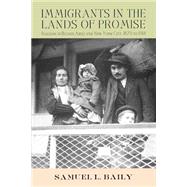
Note: Supplemental materials are not guaranteed with Rental or Used book purchases.
Purchase Benefits
Looking to rent a book? Rent Immigrants in the Lands of Promise [ISBN: 9780801488825] for the semester, quarter, and short term or search our site for other textbooks by Baily, Samuel L.. Renting a textbook can save you up to 90% from the cost of buying.
| Illustrations | ix | ||||
| Tables | xi | ||||
| Preface | xv | ||||
| Prologue: Migration from a Participant Family's Perspective | 1 | (8) | |||
| Introduction: The Comparative Study of Transnational Italian Migration | 9 | (14) | |||
| PART I: THE ITALIAN DIASPORA AND THE OLD AND NEW WORLD CONTEXTS OF MIGRATION | 23 | (68) | |||
|
25 | (22) | |||
|
47 | (22) | |||
|
69 | (22) | |||
| PART II: THE ADJUSTMENT OF THE ITALIANS IN BUENOS AIRES AND NEW YORK CITY | 91 | (148) | |||
|
93 | (28) | |||
|
121 | (24) | |||
|
145 | (27) | |||
|
172 | (19) | |||
|
191 | (26) | |||
|
217 | (22) | |||
| Appendix: Sources and Samples | 239 | (4) | |||
| Notes | 243 | (44) | |||
| Bibliography | 287 | (4) | |||
| Index | 291 |
The New copy of this book will include any supplemental materials advertised. Please check the title of the book to determine if it should include any access cards, study guides, lab manuals, CDs, etc.
The Used, Rental and eBook copies of this book are not guaranteed to include any supplemental materials. Typically, only the book itself is included. This is true even if the title states it includes any access cards, study guides, lab manuals, CDs, etc.